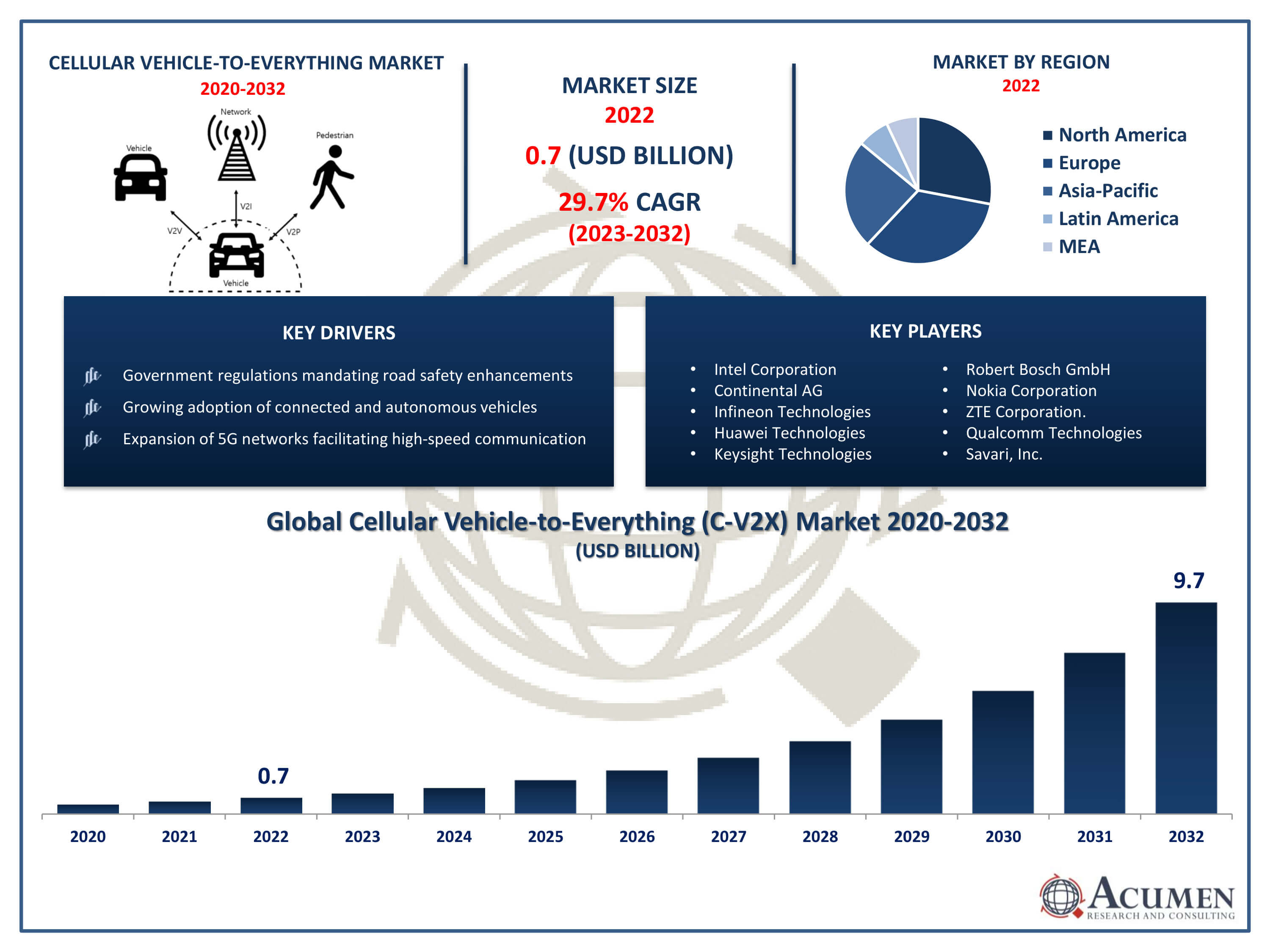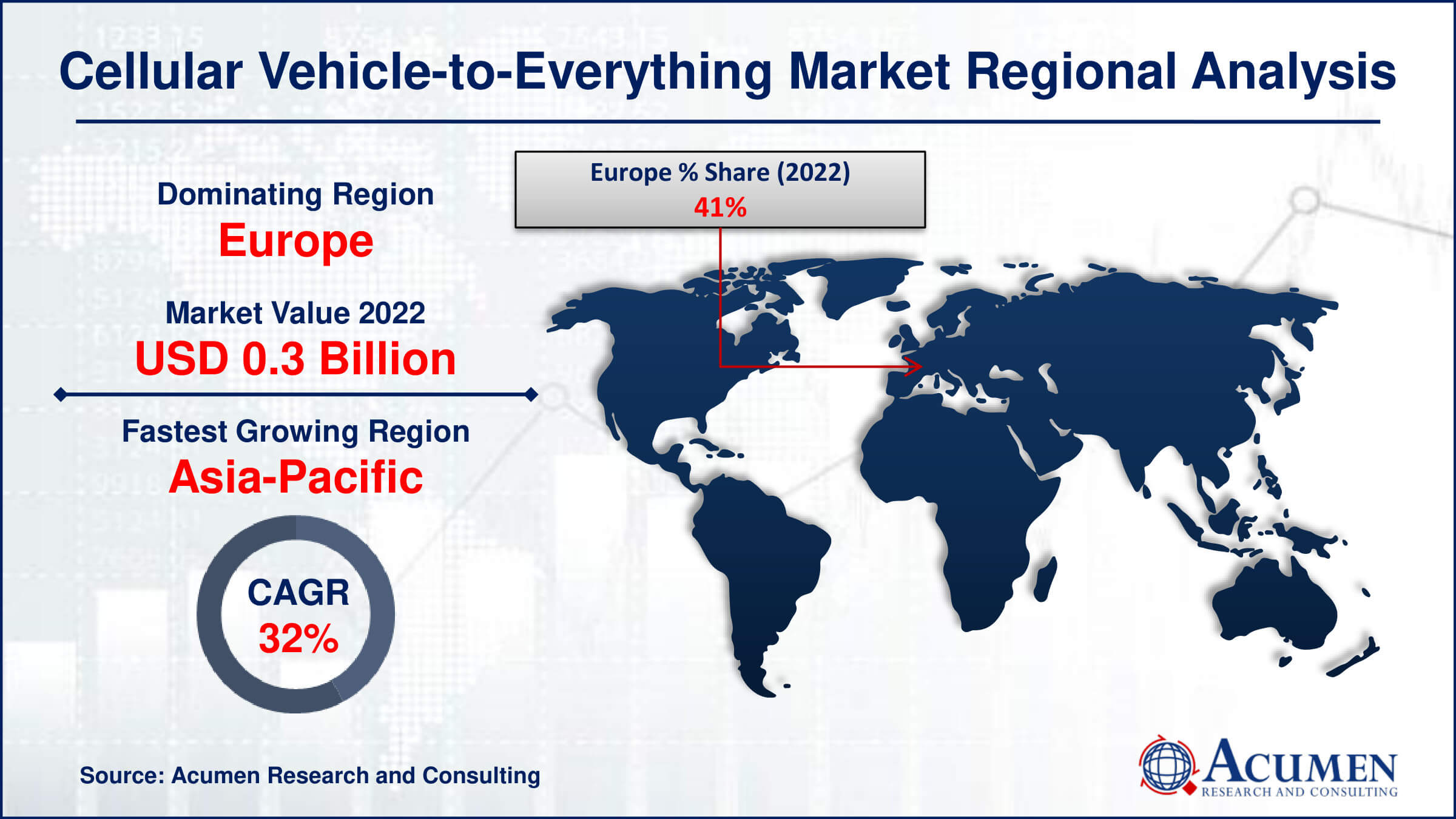January 2025
Cellular Vehicle-to-Everything (C-V2X) Market Size accounted for USD 0.7 Billion in 2022 and is projected to achieve a market size of USD 9.7 Billion by 2032 growing at a CAGR of 29.7% from 2023 to 2032.
The Cellular Vehicle-to-Everything (C-V2X) Market Size accounted for USD 0.7 Billion in 2022 and is projected to achieve a market size of USD 9.7 Billion by 2032 growing at a CAGR of 29.7% from 2023 to 2032.
Cellular Vehicle-to-Everything (C-V2X) Market Highlights

Cellular Vehicle-to-Everything (C-V2X) technology represents a pivotal advancement in the automotive industry, enabling vehicles to communicate with each other, infrastructure, pedestrians, and other devices using cellular networks. This connectivity facilitates real-time exchange of crucial information, such as traffic conditions, road hazards, and emergency situations, thereby enhancing road safety, efficiency, and overall driving experience. C-V2X encompasses various functionalities, including Vehicle-to-Vehicle (V2V), Vehicle-to-Infrastructure (V2I), Vehicle-to-Pedestrian (V2P), and Vehicle-to-Network (V2N) communications, leveraging both direct short-range communication and cellular networks.
The market for C-V2X technology is experiencing rapid growth, driven by increasing demand for advanced driver assistance systems (ADAS), connected vehicles, and autonomous driving technologies. Factors such as government initiatives to improve road safety, rising adoption of smart transportation infrastructure, and the emergence of 5G networks are fueling the expansion of the C-V2X market. Moreover, automotive manufacturers, telecom companies, and technology firms are collaborating to develop and deploy C-V2X solutions, further propelling market growth. With the potential to revolutionize transportation systems and pave the way for safer, more efficient mobility, the C-V2X market is expected to witness substantial expansion in the coming years, creating new opportunities for stakeholders across the automotive and telecommunications industries.
Global Cellular Vehicle-to-Everything Market Trends
Market Drivers
Market Restraints
Market Opportunities
Cellular Vehicle-to-Everything Market Report Coverage
| Market | Cellular Vehicle-to-Everything Market |
| Cellular Vehicle-to-Everything Market Size 2022 | USD 0.7 Billion |
| Cellular Vehicle-to-Everything Market Forecast 2032 | USD 9.7 Billion |
| Cellular Vehicle-to-Everything Market CAGR During 2023 - 2032 | 29.7% |
| Cellular Vehicle-to-Everything Market Analysis Period | 2020 - 2032 |
| Cellular Vehicle-to-Everything Market Base Year |
2022 |
| Cellular Vehicle-to-Everything Market Forecast Data | 2023 - 2032 |
| Segments Covered | By Component, By Communication Type, By Application, By Vehicle Type, And By Geography |
| Regional Scope | North America, Europe, Asia Pacific, Latin America, and Middle East & Africa |
| Key Companies Profiled | Intel Corporation, Continental AG, Infineon Technologies AG, Huawei Technologies Co., Ltd., Keysight Technologies, Robert Bosch GmbH, Nokia Corporation, ZTE Corporation, Qualcomm Technologies, Inc., Savari, Inc., Rohde & Schwarz GmbH & Co. KG, and Shenzhen Genvict Technologies Co., Ltd. |
| Report Coverage |
Market Trends, Drivers, Restraints, Competitive Analysis, Player Profiling, Covid-19 Analysis, Regulation Analysis |
Cellular Vehicle-to-Everything (C-V2X) technology enables vehicles to communicate with various entities, including other vehicles, infrastructure, pedestrians, and the broader network, using cellular networks. It represents a significant advancement in the automotive industry, facilitating real-time exchange of critical information to enhance road safety, efficiency, and overall driving experience. C-V2X encompasses different communication modes, such as Vehicle-to-Vehicle (V2V), Vehicle-to-Infrastructure (V2I), Vehicle-to-Pedestrian (V2P), and Vehicle-to-Network (V2N), leveraging both direct short-range communication and cellular connectivity. By enabling vehicles to communicate with each other and their surroundings, C-V2X can mitigate traffic congestion, prevent accidents, and optimize transportation systems. The applications of C-V2X are diverse and impactful across various domains. In terms of safety, C-V2X enables vehicles to exchange information about road conditions, potential hazards, and emergency situations in real time, thereby reducing the likelihood of accidents and enhancing overall road safety. Moreover, C-V2X plays a crucial role in improving traffic efficiency by providing traffic light optimization, route guidance, and congestion management services.
The Cellular Vehicle-to-Everything (C-V2X) market is experiencing robust growth as advancements in communication technologies reshape the automotive industry. With C-V2X, vehicles can communicate not only with each other but also with infrastructure and other connected devices, enabling safer and more efficient transportation systems. This technology leverages cellular networks, including the upcoming 5G infrastructure, to enable real-time data exchange, paving the way for enhanced road safety, reduced traffic congestion, and improved overall driving experience. One of the key drivers propelling the growth of the C-V2X market is the increasing demand for advanced driver assistance systems (ADAS) and connected vehicles. Governments worldwide are implementing regulations aimed at improving road safety, which is further accelerating the adoption of C-V2X technology.
Cellular Vehicle-to-Everything Market Segmentation
The global Cellular Vehicle-to-Everything (C-V2X) Market segmentation is based on component, communication type, application, vehicle type, and geography.
Cellular Vehicle-to-Everything Market By Component
According to the cellular vehicle-to-everything industry analysis, the software segment accounted for the largest market share in 2022. Software plays a pivotal role in enabling the seamless integration and functionality of C-V2X solutions, encompassing various aspects such as communication protocols, security mechanisms, and data analytics. As automotive manufacturers and technology firms strive to develop advanced driver assistance systems (ADAS), connected vehicles, and autonomous driving technologies, the demand for sophisticated software solutions tailored for C-V2X applications is on the rise. One of the primary drivers fueling the growth of the software segment in the C-V2X market is the need for robust and scalable platforms to support the complex communication requirements of connected vehicles.
Cellular Vehicle-to-Everything Market By Communication Type
In terms of Communication Types, the Vehicle-to-Vehicle (V2V) segment is expected to witness significant growth in the coming years. V2V communication enables vehicles to exchange critical information, such as speed, position, and trajectory, in real-time, allowing for advanced collision avoidance and cooperative driving maneuvers. With the increasing emphasis on reducing traffic accidents and improving traffic flow, the demand for V2V technology is on the rise, particularly in light of stringent government regulations mandating the integration of safety features in vehicles. One of the primary drivers propelling the growth of the V2V segment is the potential to mitigate accidents and fatalities on the roads by enabling vehicles to proactively communicate and respond to potential hazards. By leveraging C-V2X technology, V2V communication systems can provide drivers with timely warnings about impending collisions, lane changes, or other hazardous conditions, thereby preventing accidents and saving lives.
Cellular Vehicle-to-Everything Market By Application
According to the cellular vehicle-to-everything market forecast, the collision avoidance segment is expected to witness significant growth in the coming years. Collision avoidance systems leverage V2V communication, along with other sensor technologies such as radar and LiDAR, to detect potential hazards and alert drivers or take autonomous corrective actions to prevent collisions. With road safety being a paramount concern worldwide, the demand for collision avoidance solutions is escalating, driven by both regulatory mandates and consumer demand for safer vehicles. One of the primary drivers propelling the growth of the collision avoidance segment is the increasing adoption of advanced driver assistance systems (ADAS) in vehicles. ADAS features, including autonomous emergency braking, forward collision warning, and lane departure warning, rely on C-V2X technology to enhance their effectiveness by providing real-time information about the surrounding environment and potential dangers.
Cellular Vehicle-to-Everything Market By Vehicle Type
Based on the vehicle type, the passenger vehicle segment is expected to continue its growth trajectory in the coming years. This growth is driven by the increasing integration of advanced connectivity and safety features in modern vehicles. As consumers demand safer and more connected driving experiences, automotive manufacturers are incorporating C-V2X technology into passenger vehicles to enhance safety, improve traffic efficiency, and provide advanced driver assistance features. This trend is further fueled by regulatory initiatives mandating the inclusion of certain safety technologies in vehicles, thereby driving the adoption of C-V2X-enabled solutions in the passenger vehicle segment. One of the primary drivers propelling the growth of C-V2X technology in passenger vehicles is the growing awareness and acceptance of connected vehicle technologies among consumers. Features such as collision avoidance, blind-spot detection, and cooperative adaptive cruise control, enabled by C-V2X communication, are becoming increasingly sought after by consumers looking to enhance their driving experience and ensure the safety of themselves and their passengers.
Cellular Vehicle-to-Everything Market Regional Outlook
North America
Europe
Asia-Pacific
Latin America
The Middle East & Africa

Cellular Vehicle-to-Everything Market Regional Analysis
Europe is emerging as a dominant region in the Cellular Vehicle-to-Everything (C-V2X) market due to several key factors driving its growth and innovation. One of the primary reasons for Europe's dominance is the region's strong emphasis on road safety and sustainable transportation initiatives. European governments have been proactive in implementing regulations aimed at improving road safety, which has led to the widespread adoption of advanced driver assistance systems (ADAS) and connected vehicle technologies, including C-V2X solutions. This regulatory push has created a conducive environment for the development and deployment of C-V2X technology, positioning Europe at the forefront of innovation in this space. Moreover, Europe boasts a robust automotive industry ecosystem comprising leading automotive manufacturers, technology providers, and research institutions. This ecosystem fosters collaboration and innovation, driving the development of cutting-edge C-V2X solutions tailored to the region's unique transportation challenges and regulatory requirements. European automakers are at the forefront of integrating C-V2X capabilities into their vehicles, offering advanced safety features and connected services to consumers. Additionally, Europe's well-established telecommunications infrastructure, coupled with ongoing investments in 5G networks, provides a solid foundation for the widespread deployment of C-V2X communication, further solidifying the region's dominance in the market.
Cellular Vehicle-to-Everything Market Player
Some of the top cellular vehicle-to-everything market companies offered in the professional report includeIntel Corporation, Continental AG, Infineon Technologies AG, Huawei Technologies Co., Ltd., Keysight Technologies, Robert Bosch GmbH, Nokia Corporation, ZTE Corporation, Qualcomm Technologies, Inc., Savari, Inc., Rohde & Schwarz GmbH & Co. KG, and Shenzhen Genvict Technologies Co., Ltd.
Looking for discounts, bulk pricing, or custom solutions? Contact us today at sales@acumenresearchandconsulting.com
January 2025
August 2022
November 2024
December 2022